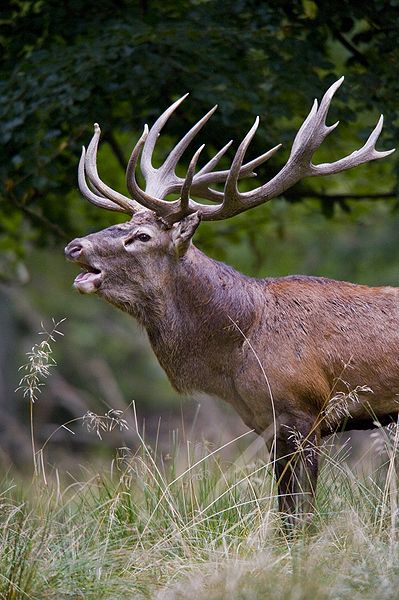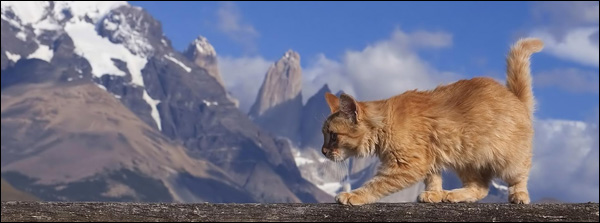Curing Winter’s Doldrums: “Still Hunting” & “Stolen Portraits”
“There are those who hunt in groups, driving deer through the forests and fields towards another hunter or group of hunters, often using dogs in those states where it is legal; and those who sit in a tree and wait for a hapless deer to walk beneath them. The deck is heavily stacked against the deer that blunders into a group of drivers and their dogs, and sitting in a tree takes unfair advantage of the fact that a deer never looks up. After all, with the exception of man, the deer’s enemies attack on the ground, not from the trees. Personally, I find both of these techniques repugnant and consider them anathema to the true woodsman’s heart. I prefer to‘still hunt.’”—Alan Gauvin
Maine Cat
By Alan Gauvin
![]() HOULTON Maine—(Weekly Hubris)—12/9/13—At the moment, there are three to four feet of accumulated snow on the ground, with drifts over six feet, and house-sized mounds created by the plows and front-loaders pushing and piling excess snow out of the way in anticipation of the next storm (which is inevitable).
HOULTON Maine—(Weekly Hubris)—12/9/13—At the moment, there are three to four feet of accumulated snow on the ground, with drifts over six feet, and house-sized mounds created by the plows and front-loaders pushing and piling excess snow out of the way in anticipation of the next storm (which is inevitable).
At this time of year, northern Maine can experience a significant snow storm every couple of weeks, with lesser coatings two or three times a month and flurries almost every day. With temperatures in the sub-zero range and lasting sunshine only a couple of days a week, it would be very easy to sink into a more or less debilitating state of torpor.
I am at present sitting at the computer, which I find kills a lot of time rather quickly but which also renders me stiff and sore, something not to be tolerated at my age. As far as outdoor winter activities are concerned, there are skiing and ice skating (both of which are contraindicated for someone with arthritic knee joints); ice fishing (which requires only marginally more exertion than sitting at the computer); and the various fall and winter hunting seasons.

There are those who hunt in groups, driving deer through the forests and fields towards another hunter or group of hunters, often using dogs in those states where it is legal; and those who sit in a tree and wait for a hapless deer to walk beneath them. The deck is heavily stacked against the deer that blunders into a group of drivers and their dogs, and sitting in a tree takes unfair advantage of the fact that a deer never looks up. After all, with the exception of man, the deer’s enemies attack on the ground, not from the trees.
Personally, I find both of these techniques repugnant and consider them anathema to the true woodsman’s heart. I prefer to “still hunt.”
This does not mean that I stand still but, rather, that I move through the woods as quietly as possible, following the track in a slow, deliberate manner; pausing frequently, sometimes for many minutes, looking ahead in hopes of getting within range of my quarry; taking advantage of trees and other features of cover; remaining poised to stop dead in my tracks when the deer raises his head to check his surroundings; and moving forward again only when he relaxes.
This is a hunting strategy historically practiced by the most accomplished of woodsmen, and unquestionably gives the deer the upper hand. I must pit my stealth and knowledge against the profound instincts and acute senses of the deer and, whether or not I succeed, I experience a feeling of personal satisfaction alien to those who practice any other hunting strategy.
Once deer season has ended, and my freezer is stocked with trout and other tasty critters (but no “venison”), I strap on my snowshoes, trade my rifle for a camera, and head back into the woods using the same techniques I used during hunting season. I set about finding a fresh set of tracks and follow them for many hours if necessary in order to get a “shot.” Snow-shoeing is terrific exercise, and taking pictures in the woods at any time is its own reward.
I must be continuously alert to the slightest movement or sound, stopping often to survey the woods around me, looking for a telltale antler, flicking ear, or tail. The deer is much more highly tuned in to his surroundings than I and is always aware of me long before I know he is there. He pays scrupulous attention to the trail behind him. A savvy buck will often double back parallel to his trail for some distance to make certain he is not being followed. If he is aware that I am skulking along behind him, he will generally not wait around and trust that my intentions are benign. But there are those occasions when he may lower his head to take a bite of browse and move off casually, seemingly un-concerned.
More likely than not, however, by the time I am aware he is looking back at me, my only reward is a quick glimpse of his ass, with that prominently raised white tail, disappearing once more into the dense cover. On an average hunt, I am observed, smelled, and heard by far more wild creatures than I ever see, regardless of how quietly I move through the woods.
In fall and early winter, each step in the woods crunches enough twigs and leaves to alert every animal within a half mile of an intruder’s presence. Even the rains at this time of year seldom make for a quiet walk in the woods; advantage, deer.
A standing layer of snow the surface of which has partially melted in the previous day’s sun and re-frozen a crusty surface over night is of further advantage to the deer. A fresh snowfall, however, muffles my footsteps and makes tracking easier.
During one such snowfall earlier this week, after an hour or so following a promising set of prints through a valley flanked by wooded, rolling hills overlooking a typical Maine trout stream, I managed to come within 50 yards of what was either a buck that had already shed its antlers, or a very large doe.
Suddenly, it turned and looked right at me, causing me to freeze with one snowshoe in the air. It was a classic stand-off. How long could I remain balanced precariously, the worst of my two bad knees supporting the entire weight of my body? Wind was not a factor, as the air in the woods was dead calm, and the puzzled animal seemed as determined to wait me out as I was determined not to spook it. After a minute or two of staring at one another, accompanied by considerable joint pain, I decided that a posture adjustment was absolutely unavoidable. The trick was to manage this as slowly and as casually as possible. Any attempt to bring my camera to eye level would have to wait.
Diverting my gaze away from the deer, I ever so slowly lowered my leg and shifted my weight to the opposite side, bringing delicious relief. I expected the deer would turn tail and disappear once again but, to my amazement, and apparently out of foolhardy curiosity, the deer began to move toward me tentatively, raising his nose in an attempt to gather a whiff of me; not yet considering me a menace. And so, intent on pushing my luck, I attempted to raise my camera, which was apparently all the further provocation he needed: he promptly showed me his tail.
The more I practice this kind of stealth, the more accomplished I become, and the more aware I am of things that I may not have consciously noticed before: the reaction of small animals to my presence and the potentially raucous alarms of blue jays, for instance. Over the years, I have learned to melt into the wooded landscape, and not stand out like some clumsy “nimrod.”
I have yet to steal a portrait this winter but, as there are still months of snow ahead, I am confident that I will succeed in my task. Whether or not I do so, it would be difficult to describe the contentment I experience each and every time I venture forth to explore Maine’s glorious winter woods.

Note: The Maine Coon kitten photo used as Alan Gauvin’s banner image may be found at http://cutepetwallpaper.com/maine-coon-cat-pics.html.

3 Comments
Martin Rosen
I went to high school with your uncle Pierre and we were best friends, when my family moved from Forest Hills I lost track. Is he still living? We used to go to jazz clubs with your grandfather and I met Sidney and Wilber DeParis and Omer Simion. We also used to go to Jimmy Ryan’s club. I would appreciate knowing what became of “Frenchy”
Best Regards
Martin Rosen
Class of 1955 Forest Hills High School
John Dusenberry
Hi Alan,
I met up with Fred Day recently in California and he said he heard from you through your blog.
Your move to Maine was really interesting. I spent an entire summer at a camp there when I was about 10, and we vacationed in Booth Bay a few times.
Anyway, It would be great to hear back from you.
John
alan gauvin
Martin, I don’t know if I answered your inquiry on a previous occasion, but I’m playing catch-up. Pierre was my brother, not my uncle, and I’m sorry to report he passed away a few years ago.